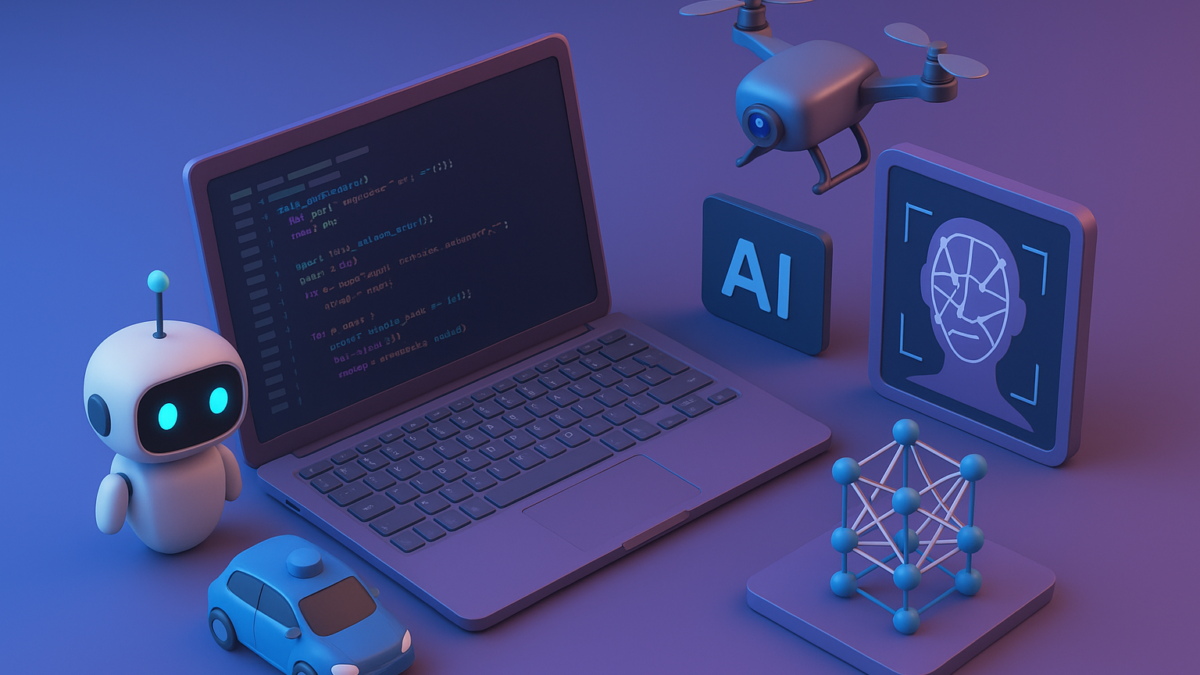10 Cool ML & AI Coding Projects You Can Build in 2025 (Beginner to Advanced)
Table of Contents
Machine learning isn’t just theory anymore. With accessible frameworks, open-source models, and powerful APIs, developers today can build AI-driven products faster than ever. Whether you’re a beginner experimenting with your first model or an experienced SWE looking for advanced AI engineering challenges, 2025 offers more possibilities than any year before.
Below are 10 cool ML & AI projects you can build ranging from simple predictive models to production-ready AI agents. Each project includes a breakdown, tech stack ideas, and why it’s worth building.
1. Personal AI Writing Assistant (Beginner ↗ Intermediate)
A small-scale LLM-powered assistant that helps rewrite, summarize, or generate content.
What you’ll learn:
- Prompt engineering
- Working with OpenAI API / Llama 3
- Building user interfaces with React or Streamlit
Tech stack: Python, FastAPI, OpenAI API, Streamlit
Why it’s cool:
It shows you how LLMs behave, how to control them, and how to deploy a simple AI app which is exactly what companies look for today.
Check out OpenAI’s docs for simple examples of text-based AI apps.
2. ML-Powered Stock Price Predictor (Beginner)
Classic ML project but still one of the best to learn fundamentals.
What you’ll build:
- A regression model using LSTM / XGBoost
- Visual dashboard of historical vs predicted prices
- Automated alerts
What you’ll learn:
- Time-series forecasting
- Data preprocessing
- Overfitting prevention
Internal link idea:
Link to your AI / Martech / Future Tech category on iTMunch.
3. AI Resume Analyzer for Job Seekers (Beginner)
A tool that evaluates resumes, scores them, and suggests improvements using embeddings.
What you’ll learn:
- Text classification
- Vector similarity search
- Prompt design for scoring rubrics
Why it’s useful:
It’s practical enough to be used by real job seekers.
4. Voice-Controlled Personal Assistant (Intermediate)
An assistant that responds to voice commands like “Open Chrome”, “Play Spotify”, or “Send email”.
Tech stack:
- Speech-to-text: Whisper
- NLP: Llama or GPT
- Voice output: TTS models
- Python automation libraries
What you’ll learn:
- Audio processing
- Real-time inference
- Intent classification
5. ML System for Detecting Fake News (Intermediate)
A text classification model detecting misinformation.
Build components:
- Dataset collection using crowdsourced sources
- Fine-tuned transformer model
- Real-time classification API
- Dashboard to display credibility scores
Skills gained:
- Model fine-tuning
- API deployment
- Evaluation metrics like F1, precision, recall
6. AI Agent That Books Appointments Automatically (Advanced)
AI agents are the hottest trend of 2025.
What it does:
- Reads your emails
- Understands intent (“dentist appointment”, “visa slot”, etc.)
- Interacts with websites
- Books appointments on your behalf
Tech stack:
- Agent frameworks like LangGraph
- Browser automation (Playwright)
- LLM as reasoning engine (GPT-4.1, Claude 3.5)
Why this is impressive:
This is the kind of project top engineers at Google and OpenAI are experimenting with it demonstrates real-world autonomy.
7. Real-Time Sign Language Detection (Advanced)
A computer-vision project that converts sign gestures to text.
What you’ll learn:
- Pose estimation
- CNNs / Transformers for video
- Real-time video inference
- GPU optimization
Tech options:
- MediaPipe
- PyTorch
- TensorFlow
- OpenCV
This one stands out because it solves a real accessibility problem.
8. AI Game Bot That Beats Simple Browser Games (Advanced)
Think: Dino Game, 2048, Tic Tac Toe, Flappy Bird.
Approach:
- Reinforcement learning (DQN / PPO)
- Environment simulation
- Policy evaluation and refinement
Why build this:
RL remains one of the most respected ML specializations and Google engineers LOVE RL experiments.
9. Personalized News Recommendation Engine (Intermediate)
A recommendation system using collaborative filtering + embeddings.
Pipeline includes:
- Vector representation of news
- User embedding models
- Ranking algorithm
- Feedback loop to improve results
Outcome:
A working version of what YouTube, TikTok, and Google News use at scale.
10. Full LLM Chatbot With Memory + Personality (Advanced)
Unlike basic chatbots, this one includes:
- Long-term memory
- Persona definitions
- Tool use (search, calculator, API calls)
- Context windows and compression
- Analytics dashboard
Why it’s cool:
It demonstrates how production-ready AI assistants work, not just demo-level chatbots.
Step-by-Step Guide: How to Pick the Right Project
Choosing a project depends on your goals. Use this quick guide:
If you want to learn ML fundamentals:
→ Build Projects 2, 3, or 5
If you want applied AI that works in real life:
→ Build Projects 1, 4, or 9
If you want to impress a recruiter or SWE:
→ Build Projects 6, 7, or 10
If you want something fun:
→ Build Project 8
Real-World Proof: Why These Projects Matter
Today’s engineering interviews at companies like Google, DeepMind, and OpenAI value:
- end-to-end thinking
- ability to deploy models
- understanding trade-offs
- debugging skills
- production-readiness
These projects help you demonstrate exactly those skills much more than traditional Kaggle notebooks.
(Google’s official ML guide) https://developers.google.com/machine-learning
Conclusion
The world of machine learning is evolving fast, but the best way to grow as a developer is still simple: build projects that challenge your thinking and push you beyond tutorials. These 10 AI projects ranging from beginner-friendly apps to advanced agent-based systems give you real, hands-on experience with technologies shaping the future.
Whether you’re preparing for ML interviews, creating a portfolio, or simply exploring the field, these ideas help you develop skills that stand out in 2025 and beyond.





